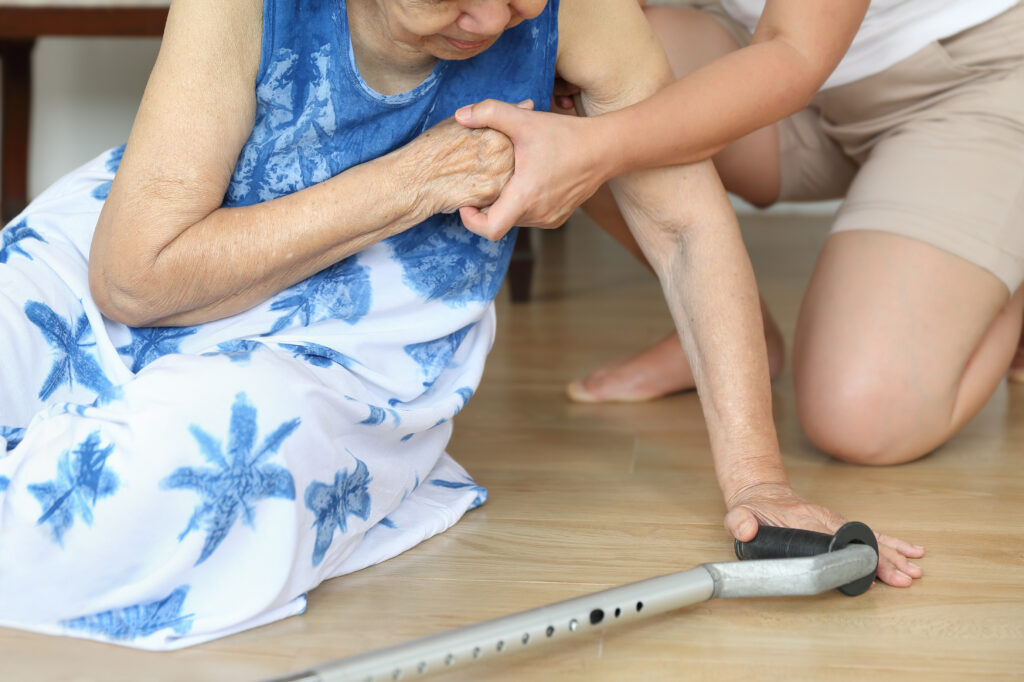The fear that your loved one will fall and be unable to get help is real and unsettling. Falling is a leading cause of serious injury in older adults. In fact, the Center for Disease Control reports that more than one in four adults over 65 fall every year, and less than half tell their doctor about it. Falls in the senior population result in over 800,000 hospitalizations a year. If you fall once, your chances of falling again double. These statistics are alarming, and caregivers should recognize what may add to the risk of falling and how to minimize that risk.
Most falls are the result of many risk factors including lower body weakness, balance issues, vision problems, osteoporosis, and trip hazards. One often overlooked risk factor is medication. Fall risk associated with medication can be affected by type of medication, drug metabolism, drug-drug interaction and overprescribing. The following groups of medications can make a senior more susceptible to falling. Here you can learn why these medications are prescribed and why they might increase fall risk.

Psychotropic Medications
Healthcare professionals prescribe psychotropic drugs to treat disorders related to mental health. A psychotropic describes any drug that affects behavior, mood, thoughts, or perception. Basically, these medications work by altering or balancing chemicals in the brain called neurotransmitters. Some mental health problems improve when neurotransmitters like dopamine, serotonin, or norepinephrine increase or decrease.
About 20% of all adults over 65 take at least one type of psychoactive medication. This increases to 80% in seniors living in nursing homes and assisted living facilities. Categories of psychotropic medications include antidepressants, antipsychotics, and drugs used to treat dementia, bipolar disorder, insomnia, anxiety, and pain.
Benzodiazepines (e.g. Xanax, Valium, Ativan) are commonly prescribed and widely associated with increased fall risk. They have a sedative effect, and the risk of fall increases with higher doses of this drug class. Even short-acting benzodiazepines can be unsafe in seniors with other fall risk factors.
Sleep medications (e.g. Ambien, Lunesta, Sonata) also heighten fall risk because of impaired psychomotor function. The highest risk of fall is seen in seniors who take a sleep medication every night. Even over-the-counter medications to treat occasional insomnia, mostly antihistamines, are associated with fall risk in older adults.
Pain medications, especially opioids, put seniors at a seven-fold risk of falling compared to older adults who take over-the-counter medications such as ibuprofen or acetaminophen. These falls occur because side effects of dizziness, loss of coordination, and balance are common with opioid use.

Anticholinergics And Antimuscarinics
This group of medications helps to regulate the functions of the parasympathetic nervous system, which controls many involuntary functions such as muscle contraction, dilation of blood vessels, increased bodily secretions or gastrointestinal activity. Medications in this class are used to treat symptoms of an overactive bladder, irritable bowel syndrome, Parkinson’s Disease, and lung problems such as asthma. Side effects may include blurred vision, light sensitivity, mood changes, confusion, or disorientation. These all contribute to the risk of falling. Lower doses of anticholinergics and antimuscarinics have been shown to decrease fall risk.
Cardiovascular And Hypertension Drugs
Hypertension, or increased blood pressure, is treated with medications that block the body’s production of a substance that tightens blood vessels. Side effects of dizziness, gait, and balance impairment are the main contributors to fall risk in seniors. A condition called postural hypotension is also a side effect of many blood pressure medications. This occurs when your blood pressure suddenly drops when you change position from lying down to sitting up or from sitting to standing. This greatly increases fall risk when dizziness and disorientation occur.
Popular heart medications used to treat atrial rhythm disorders include beta-blockers digoxin and amiodarone. The main risk of falling from these drugs comes from fainting. As many as 40% of patients who take certain cardiovascular medications have experienced dizziness and feeling faint enough to double their risk of falling.

What Can I Do to Minimize the Risk of Falling from Medications?
The medications mentioned here do not represent a comprehensive list of drugs that may increase fall risk, and not everyone who takes them may have that increased risk. Fortunately, medications are an easy risk factor to change. Make sure to provide your primary doctor with a list of all of your medications, including over-the-counter drugs and supplements. Ask your provider to review the list specifically with increased fall risk in mind.
Your healthcare professional may stop medication when possible, switch to an alternative medication with less side effects, or reduce the dosage of medicine associated with fall risk. It is imperative that seniors and their caregivers listen carefully and follow the directions of their primary care providers. Clinicians will appreciate a proactive approach and help to adjust medications to reduce fall risk or confirm the necessity of the medication’s benefits over that risk. You can then rest assured that you’ve crossed one risk factor off the list to keep your senior loved one safe.
—
de Jong MR, Van der Elst M, Hartholt KA. Drug-related falls in older patients: implicated drugs, consequences, and possible prevention strategies. Therapeutic Advances in Drug Safety 2013; 4:147–154.
Hill KD and Wee R. Psychotropic Drug-Induced Falls in Older People: A Review of Interventions Aimed at Reducing the Problem. Drugs and Aging 2012; 29:15-30.
